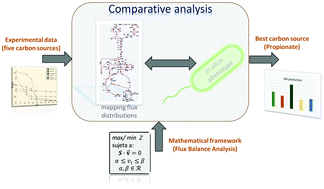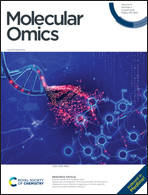Propionate as the preferred carbon source to produce 3-indoleacetic acid in B. subtilis: comparative flux analysis using five carbon sources†
Abstract
3-Indoleacetic acid (IAA) is a phytohormone that promotes plant root growth, improving the use of nutrients and crop yield and it is been reported that bacteria of the genus Bacillus are capable of producing this phytohormone under various growth conditions. Considering this metabolic capability, in this work, Bacillus subtilis was cultivated in five different carbon sources: glucose, acetate, propionate, citrate and glycerol; and L-tryptophan (Trp) was used as an inducer for the IAA production. Based on the experimental results it was observed that the highest growth rate was achieved using glucose as a carbon source (μ = 0.12 h−1) and the lowest value was for citrate (μ = 0.08 h−1). On the other hand, the highest IAA production was obtained using propionate Yp/s = 0.975 (gIAA gTrp−1) and the lowest was when glucose was the substrate Yp/s = 0.803 (gIAA gTrp−1). In order to explore the metabolism and understand these differences, the experimental data was used to calculate the flux distribution using the genomic-scale metabolic model of Bacillus subtilis. Performing a comparative analysis it is observed that the fluxes towards precursors increase when propionate is the carbon source.



 Please wait while we load your content...
Please wait while we load your content...